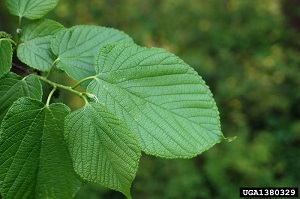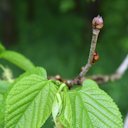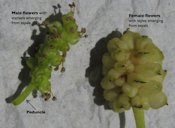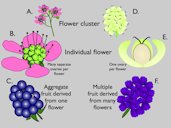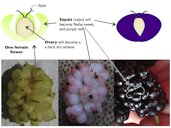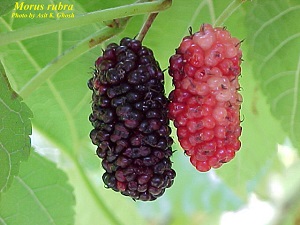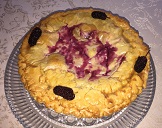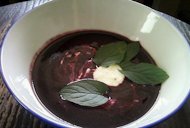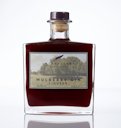| Mulberry, Red - Morus rubra | |||||||||||||||||||||||||||
|---|---|---|---|---|---|---|---|---|---|---|---|---|---|---|---|---|---|---|---|---|---|---|---|---|---|---|---|
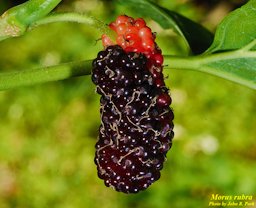 Fig. 1  Morus rubra L., red mulberry 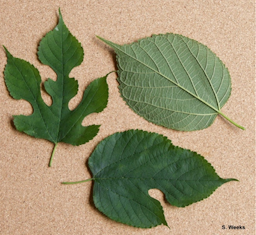 Fig. 2  A distinguishing feature of M. rubra is a pronounced acuminate leaf apex (tip of leaf).  Fig. 3  Red mulberry (M. rubra), Leaves of sprouts are often strongly lobed with one or two (or occasionally more) lobes. 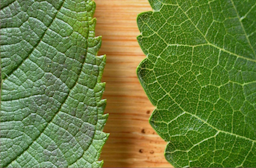 Fig. 4  Upper leaf surfaces of rubra (L) and alba (R): in rubra, note wrinkling with impressed veins, major lateral veins curving up to join adjacent ones, and sharper teeth.  Fig. 5  Underside of leaves, red mulberry-L, white mulberry-R. Note the typical difference in vein pattern. 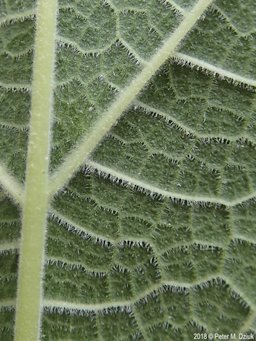 Fig. 6  Hairs on leaf underside 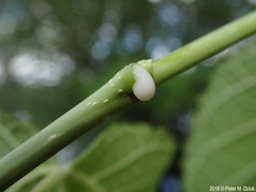 Fig. 7  New twig with milky sap 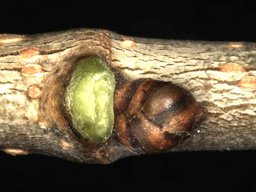 Fig. 8  Leaf scar concave, oval to half-moon shape 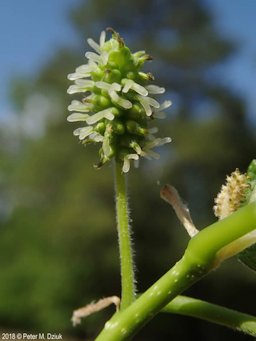 Fig. 12  Female flowers 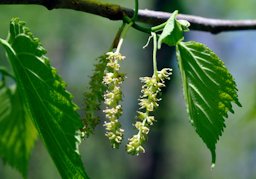 Fig. 13  Red mulberry staminate inflorescence  Fig. 14  Flowering shoot, with male catkins 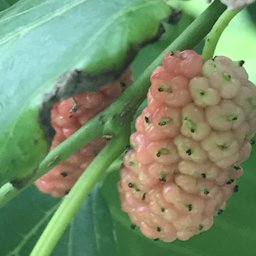 Fig. 19  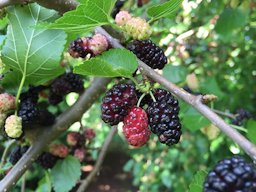 Fig. 20  Female catkins become nodding to pendulous fruit clusters, 3/8 to 1+ inches long, resembling elongated raspberries or blackberries. The color of fruit ranges from white to pink to red, but all turn purplish-black when mature. 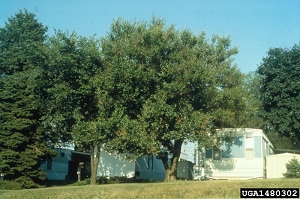 Fig.23  Red mulberry M. rubra L. tree 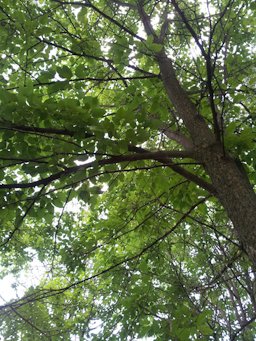 Fig. 24   Fig. 25  M.rubra habit 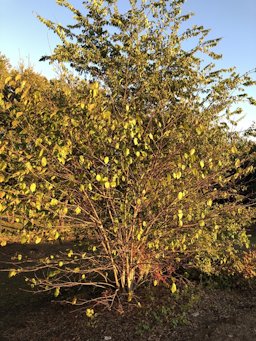 Fig. 26  Leaves turn yellow in the fall 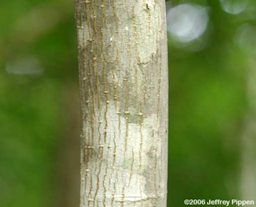 Fig. 27  Bark of young to medium trees is fairly smooth but with bumps from lenticels. 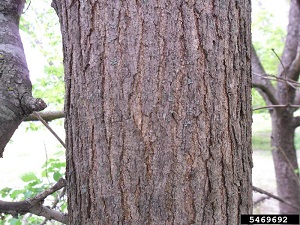 Fig. 28  Bark of medium tree eventually develops longitudinal lines and shallow splits. 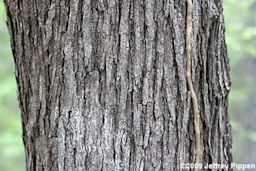 Fig. 29  Older bark is rougher and more furrowed and slightly peeling.  Fig. 30  Large root of a red mulberry tree causing an asphalt walking path to buckle in the Franklin Glen section of Chantilly, Fairfax County, Virginia. 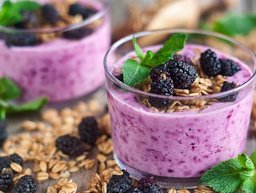 Fig. 35  Mulberry smoothie with granola 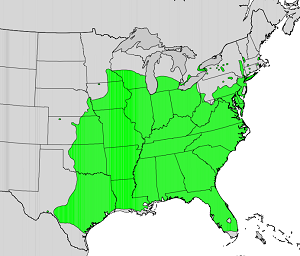 Fig. 37  Range map of M. rubra | Scientific
name Morus rubra L. Pronunciation MOR-russ ROO-bruh Common names English: red mulberry; French: mûrier rouge; German: roter maulbeerbaum; Spanish: moral rojo; Swedish: rött mullbär 22 Synonyms M. canadensis Poiret; M. murrayana Saar & Galla; M. reticulata Rafinesque; M. riparia Rafinesque; M. rubra Linnaeus var. tomentosa (Rafinesque) Bureau; M. rubra var. japonica Makino 9,10 Relatives Korean mulberry (M. australis), Himalayan mulberry (M. laevigata); breadfruit (Artocarpus altilis), jackfruit (A. heterophyllus), fig (Ficus spp.), che (Cudrania tricuspidata), African breadfruit (Treculia african) 1 Family Moraceae Origin Native to northern America 22 USDA hardiness zones 5b-10b 7 Uses Fruit eaten out of hand; used as shade tree; attracts wildlife; has been used by native people of the eastern United States for centuries 2 Height 15-70 ft (4.6-21.3 m) 8 Spread 50 ft (12 m) 5 Crown Rounded, dense canopy 2 Plant habit Spreading with a high canopy 5 Growth rate Grows wild in dry fields, pinelands and moist woods, where they can form a thicket of rapid-growing trees 2 Longevity Usually lives 125 years or less 21 Trunk/bark/branches Short trunk; stout, spreading branches; branchlets covered with short hairs; twigs have scattered white lenticels (Fig. 27); bark is grayish with flattened, scaly ridges; if inner bark is exposed, it tends to be tan-colored 4,15 Pruning requirement Train the branches to a sturdy framework and little pruning is required Leaves Deciduous; simple; alternately arranged; heart-shaped; between 2-8 in. (5-20 cm) 8 Flowers Usually dioecious; less often it is monoecious; greenish to white; inconspicuous; clusters (catkins); blooms April/May 2,20 Fruit Red to dark purple; ripen in late spring; 1-1.5 in. (2.5-4 cm); aggregate of drupelets or are made up of several tiny, one-seeded fruits 8 Season June to Aug. 21 USDA Nutrient Content pdf Light requirement Full sun to partial shade 5 Usually found growing in the shade of larger trees 18 Soil tolerances Prefers moist, organic-rich soil, but will thrive in drier soil types once established; appears to thrive in the infertile sandy soil found across much of Florida 3,6 pH preference A wide range of soil pH is tolerated 20 Drought/flood tolerance Once established it can survive drought and extended flooding 3 Aerosol salt tolerance Good in mild zone 5 Soil salt tolerance Moderate on coast 5 Wind tolerance Medium to low resistance 8 Cold tolerance Hardy to sub-zero temperatures 1 Plant spacing At least 15 ft (5 m) apart 1 Roots Shallow root system 20 Invasive potential * None reported Pest resistance The Caribbean fruit fly sometimes infests the fruit in south Florida 6 Known hazard Fruit leaves an indelible stain 6 Male trees are extremely allergenic and should be avoided, while female trees cause few or no allergies. The pollen from members of the Morus genus can cause allergies ranging from hay fever to asthma. 8 Reading Material The Red Mulberry: A Bird Attracting Plant for South Florida, Fairchild Tropical Botanic Garden Morus rubra, Red Mulberry, University of Florida pdf Morus rubra, Floridata A Mess of Muddled Mulberries, Bluegrass Woodland pdf Red and White Mulberry in Indiana, Purdue University pdf Origin This native deciduous tree is generally found in the moist soils of mesic hardwood forests, floodplains, and other moist sites from south Florida, west to Texas, north to Minnesota and the extreme southern portion of Ontario, Canada, and east to the Mid-Atlantic states. 8 Natural History red mulberry Red mulberry is a member of the mulberry family (Moraceae). It is fire-intolerant, but may colonize post-fire sites when sufficient moisture is available. It is native to eastern North America, but while it is a common species in the United States, it is listed as an endangered species in Canada. Additionally, red mulberry is threatened by extensive hybridization due to the introduction of the invasive white mulberry (Morus alba), which originates from Asia. 12 Description Open grown red mulberry trees are very uncommon, but they tend to have short trunks with large, low, spreading limbs, making fruit picking a breeze! 4 Red mulberry grows well in open locations under full exposure to the sun. It reaches heights of 15 to 70 feet, growing larger in its northern ranges. 8 These trees produce reddish or black fruits that are considered to be good quality. Red mulberry trees grow fairly quickly and are able to provide you with shade and fruit relatively soon after planting. 18 Red mulberry trees and white mulberry trees can both grow quite large while black mulberry trees are generally the smallest. When considering their mature size, black mulberry trees may be the most practical choice for home gardens. 18 It should be noted, nearly all mulberries will grow even in the extreme tropics, but disease problems and fruiting issues from lack of winter chill can make growing problematic. 3 Key features for separation of red mulberry and white mulberry, Purdue University Leaves Leaves occur in three general shapes: entire, mitten (single lobed), and three-lobed (Fig. 2). Red mulberry leaves are usually larger (4-10 inches) than white (3-4 inches). Red mulberry has dull, dark green leaves that are scabrous (rough) on top and usually lightly hairy beneath. Minor veins are numerous and obvious. Its margins are usually finely serrate when compared to those of white mulberry (Fig. 4). 4 The lower leaf surface of Morus rubra is quite hairy (Fig. 6), giving a soft pubescent feel when lightly stroked. Morus rubra leaves (and most hybrids) will have a sandpaper like feel when stroked gently on the upper leaf surface in the direction of the petiole. Morus alba cultivars will feel nearly the same in either direction. 3 The single most useful character to distinguish between red and white mulberry is the degree of hairiness on lower leaf surfaces. “Red” mulberry has dense long erect hairs (mostly 0.4–0.7 mm long), which feel distinctly soft to the touch. “White” mulberry has sparse short appressed hairs (mostly 0.2–0.5 mm long), largely restricted to major veins and providing no ‘felty’ feeling. 7
Fig. 11. Note the black band aound the margin of each bud scale Flowers Mulberry trees are either dioecious or monoecious, and sometimes a tree even will change from one sex to another. Hight temperatures, strong light, and long days favor maleness in mulberries, with their opposites, as well as high humidity, bringing out female flowers. 15 Red mulberry has larger, more flattened buds than the white mulberry, that often sit off-center on the twig; the margin of each scale has a black band. 4 The flowers are held on short, green, pendulous, nondescript catkins that appear in the axils of the current season's growth and on spurs on older wood. 1 Red mulberry (M. rubra) can have both male and female trees as well as male and female flowers on the same tree. Only female trees or those with both male and female blooms will produce fruit. 2 The greenish to white inconspicuous flowers appear in clusters in the spring, with male and female flowers occurring either on the same tree or separate trees. 8 Mulberries cluster their tiny flowers together into dense and well-defined inflorescences. And, all the flowers on an inflorescence then develop into a single fused unit, which we casually call a fruit. Mulberries make separate flowers with only one or the other sex: “female” flowers lack stamens, and “male” flowers lack pistils (Fig. 15). Both female and male flowers also lack petals. So, for example, a “female” mulberry flower will have only sepals and a pistil, and a “male” flower will have only sepals and stamens. Male flowers therefore cannot make fruit just as female flowers cannot make pollen. Tiny mulberry flowers make miniscule fruits; by sticking together across the entire inflorescence, they masquerade as one large fruit and probably enhance their power to entice birds and improve their dispersal efficiency. But that’s not the mulberry’s only beauty secret. Strictly speaking, mulberry fruits are not that attractive. They are hard dry achenes with the appeal of a grain of sand. To make themselves sweet and juicy, they plump up the only other flower parts they have - their sepals (Fig. 17). This is in contrast to blackberries, denizens of the rose family (Rosaceae), whose flowers, fruits and seeds are structurally distinct from those of mulberries (Fig. 16). 19
Fig. 16. A-C Blackberry. D-F Mulberry. Mulberries resemble blackberries, but blackberries derive from a single flower with multiple fleshy ovaries, whereas mulberries derive from multiple flowers, each with a single hard ovary and fleshy sepals. Fig. 17. Mulberry flowers becoming fruits Fruit The fruits of the M. rubra are usually deep red, almost black, and have a flavor that, in the best clones, almost equals that of the delectable black mulberry. 13 Red mulberry fruit is generally larger (>1 inch) and sweeter than white mulberry (3⁄4 inch), and since it is almost always found in shady, wooded areas where it produces a sparse fruit crop. Single fruits hang along the twig, in contrast to the clusters of abundant, axillary fruit usually present on white mulberry. 4
Varieties Morus rubra is native to North America, but pure strains of M. rubra may be becoming rare, as one study of Red Mulberries in Canada put the occurrence of hybridization with Morus alba at 54%. 17 Some cultivars for M. rubra: 21 'Hick's Everbearing', Zones 5-9 'Johnson', Zones 5-9 'Stubbs' (from 1870 Georgia), Zones 5-9 'Travis', Zones 5-9 Wild type, Zones 5-10 Hybrid Mulberry; Morus 'Illinois Everbearing', Arthur Lee Jacobson Harvesting Fruit should be allowed to thoroughly ripen on the tree for best quality and flavor. Harvest by shaking the branches over a clean sheet in May. 11 Separate ripe fruits from the leaves, twigs, insects, and unripe fruits that also fall by dumping the whole mess into a pail of water. Everything except the ripe berries will float and can be decanted. 13 Pollination Mulberries are pollinated by wind. Propagation Mulberries can be grown from seed, although the plants can take 10 years or more to bear. Seed should be sown as soon as extracted from the fruit. 1 Sprig budding is the most common method for grafting mulberries. Other types of grafts are also usually successful, although there may be incompatibility between white and black mulberries. Hardwood, softwood and root cuttings also are suitable methods for propagating mulberries. Red mulberry can be propagated from stem cuttings, root sprouts, air-layering or by budding. 2 Pruning No special pruning techniques are needed after the branches have been trained to a sturdy framework, except to remove dead or overcrowded wood. A mulberry tree can be kept to a tidy form by developing a set of main branches, and then pruning laterals to 6 leaves in July in order to develop spurs near the main branches. It is not advisable to prune the trees heavily since the plant is inclined to bleed at the cuts. Cuts of more than two inches in diameter generally do not heal and should be avoided at all cost. The bleeding will be less severe if the tree is pruned while it is dormant. 1 Fertilizing A granular fertilizer like 8-3-9 or similar formulation should be applied in June and August. The granular fertilizer should be spread lightly below the drip line. A foliar minor element spray and chelated iron drench can be done in June and August to improve the growth of the tree. Iron chelate is expensive, but under South Florida conditions it will make a large difference in the performance of your tree. 2 Irrigation The first year is a critical time for the establishment of a new mulberry. Water thoroughly twice a week on light soils and once a week on clay soils. Soak the entire root system deeply. 11 Although somewhat drought-resistant, mulberries need to be watered in dry seasons. If the roots become too dry during drought, the fruit is likely to drop before it has fully ripened. 1 Pests/Diseases Mulberries are generally free of pests and diseases, although cankers and dieback can occur. In some areas "popcorn disease" is an occasional problem, in which fruits swell to resemble popped corn. M. alba/M. rubra hybrids are particularly prone to this condition. The disease carries on from one season to the next, so collecting and burning infected fruits help control it. 1 Food Uses The berries can be eaten out of hand or used in any way that other berries are used, such as in pies, tarts, puddings or sweetened and pureed as a sauce. Slightly unripe fruits are best for making pies and tarts. Mulberries blend well with other fruits, especially pears and apples. They can also be made into wine and make an excellent dried fruit, especially the black varieties. 1 Dried mulberries are a great snack and are almost addictive when placed on top of granola or cereal. Dry in a food dehydrator at 135 degrees F. for 14 to 24 hours (They will be crunchy when completely dried). Even unripe mulberries taste good when dried. 3 Unwashed berries will keep several days in a refrigerator in a covered container. 1
Fig. 31. Mulberry pie Fig. 32. Cold mulberry soup with ginger yogurt Fig. 33. Mulberry gin liqueur Fig. 34. Mulberry lemonade Medicinal Properties ** Many tribes used different parts of mulberry to treat various sicknesses. For instance, the Alabama and Creek Indians treated urinary tract issues using an extract made from mulberry root. The Rappahannock took the sap and rubbed it over skin to treat ringworm, and the Cherokee steeped the bark and ingested the liquid to loosen stool and get rid of intestinal worms. The Meskwaki used the root bark as a cure for a wide range of ills. 8 Other Uses There are records of the Timucua Indians of northeast Florida using the leaves, twigs and berries to make dyes, and Seminoles using the branches to make bows. Other Indians more to the north consumed the dried fruits during the winter. They would mash, dry and store mulberry fruit, then add them to water to make warm sauces that they sometimes mixed into cornbread. The Cherokee made sweet dumplings by mixing cornmeal and sugar with the fruit. In the past, the fruits were also valued for fattening hogs and chickens but this practice is rarely used today. 2 The wood from mulberry trees has also been used in the construction of furniture, boats and tubs and even as fence posts because the heartwood is relatively durable. Other uses of the wood include farm implements, furniture, interior finishing and caskets. 2 Other Edible Morus species: Black Mulberry, Morus nigra White Mulberry, Morus alba General Red mulberry is listed as Endangered or Threatened in Connecticut, Massachusetts, Vermont, Michigan and Ontario, due largely to hybridization with the introduced white mulberry. 3 As for the name, Ruba is red. Morus is a bit more involved. A Babylonian story later incorporated into Greek mythology attributes the reddish color of the mulberry fruit to the tragic death of lovers. The Greek god Moros, who drove men to their fate, arose from that and where we get the English word, through Dead Latin, “morose.” Contemporary Greeks call the mulberry Mouro and southern Greece, Peloponnese region, is often called Mora because it is roughly shaped like a mulberry leaf. 14 The word "mulberry" has an interesting etymological evolution. The Old High German word for berry, beri, was combined with the Latin word morus to make the word múlbere. This word (múlbere) then morphed into the German name Maulbeer, which then transformed into the Dutch word moerbezie, and eventually the English word mulberry. 8 One thing about using mulberries is that your hands turn purple. I tried everything to remove the stain. I remembered I kept an article from 1977 from "Your Garden" magazine and there it was - the answer. Use the juice of green mulberries to remove stains on hands etc. I collected some green mulberries, rubbed the juice into my hands and instantly the stains disappeared. 16 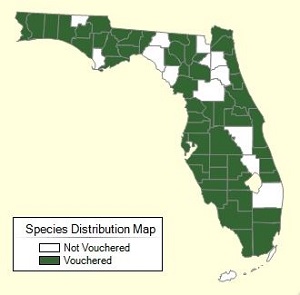 Fig. 36  M. rubra L. Florida species distribution map Further Reading Morus rubra L., red mulberry, USDA-NRCS PLANTS Database pdf Morus rubra L., red mulberry, Michigan Natural Features Inventory pdf Mulberry Tree, Just Fruits and Exotics nursery Mulberry, California Rare Fruit Growers Mulberry Express, Eat The Weeds Mulberry Botanical Art List of Growers and Vendors | ||||||||||||||||||||||||||
| Bibliography 1 "Mulberry." California Rare Fruit Growers, 1996, crfg.org/wiki/fruit/mulberry/. Accessed 16 Oct. 2017. 2 Ledesma, Noris. "The Red Mulberry: A Bird Attracting Plant for South Florida." Fairchild Tropical Botanic Garden, Article published in the Miami Herald, 7 May 2012, fairchildgarden.org/News-Pressroom-Media-Center/Articles/the-red-mulberry-a-bird-attracting-plant-for-south-floridaMiami Herald. Accessed 17 Oct. 2017. 3 Christman, Steve. "Morus rubra." Floridata, no. 1270, Published 30 Aug. 2016, floridata.com/plant/1270. Accessed 23 Mar. 2020. 4 Weeks, Sally S. "Red and White Mulberry in Indiana." Department of Forestry and Natural Resources, Purdue University, FRN-237, 17 Sept. 2003, Reviewed 1 Sept. 2015, mdc.itap.purdue.edu/item.asp?itemID=19438. Accessed 11 Mar. 2020. 5 SelecTree. "Morus rubra Tree Record." SelecTree, Urban Forest Ecosystems Institute, 1995-2017, selectree.calpoly.edu/tree-detail/morus-rubra. Accessed 17 Oct 2017. 6 Boning, Charles R. Florida's Best Fruiting Plants- Native and Exotic Trees, Shrubs, and Vines. Sarasota, Pineapple Press, 2006. 7 Campbell, Julian. "Characters that tend to differentiate red mulberry (rubra) versus white mulberry (alba)." Taxonamic and Ecological Notes, Morus: Muddled Mulberries, Bluegrass Woodland, bluegrasswoodland.com/Notes_on_Species.html. Accessed 21 Oct. 2017. 8 Andreu, Michael G. et al. "Morus rubra, Red Mulberry." School of Forest Resources and Conservation, UF/IFAS Extension. FOR 264, Original pub. June 2010, Reviewed Apr. 2016. edis.ifas.ufl.edu/fr326. Accessed 22 Oct. 2017. 9 The Plant List (2013). Version 1.1. Published on the Internet. www.theplantlist.org. Accessed 24 Oct. 2017. 10 Wunderlin, R. P., et al. "Morus rubra L."Institute for Systematic Botany, University of South Florida, Tampa, S. M. Landry and K. N. Campbell (application development), USF Water Institute, 2017, Atlas of Florida Plants, florida.plantatlas.usf.edu/Plant.aspx?id=3420. Accessed 24 Oct. 2017. 11 Cowley Gilbert, Brandy. "Mulberry Tree." www.justfruitsandexotics.com/JFE/product-category/fruit-trees/mulberry/#lightbox/0/. Accessed 25 Oct. 2017. 12 "Red mulberry." University of Florida School of Forest Resources and Conservation, 4-H Forest Resources, www.sfrc.ufl.edu/extension/4h/trees/Red_mulberry/. Accessed 26 Oct. 2017. 13 "Thai silk." Wikipedia, en.wikipedia.org/wiki/Thai_silk. Accessed 27 Oct. 2017. 14 Deane, Green. "Mulberry Express." Eat the Weeds and other things, too. www.eattheweeds.com/mulberry-glucose-controlling-hallucinogen-2/. Accessed 27 Oct. 2017. 15 Hurteau, Matthew D. "Red Mulberry, Morus rubra L." Plant Guide, National Plant Data Center, USDA, NRCS, National Plant Data Team, Greensboro, NC 27401-4901, USA, 2020, The PLANTS Database, plants.usda.gov. Accessed 13 Mar. 2020. 16 Gray, Christine. "Making Use of the Mulberry." Archives of the Rare Fruit Council of Australia. March 1995. Accessed 27 Oct. 2017. rfcarchives.org.au/Next/Fruits/Mulberry/Mulberry3-95.htm. Accessed 27 Oct. 2017. 17 Burgess, K. S., et al. "Asymmetrical introgression between two Morus species (M. alba, M. rubra) that differ in abundance." Molecular Ecology 14, 3471–3483, 2005, Growing Mulberry, www.growingmulberry.org. Accessed 20 Mar. 2020. 18 "Mulberry (Morus spp.)." Gardening Solutions, UF/IFAS, gardeningsolutions.ifas.ufl.edu/plants/trees-and-shrubs/trees/mulberry.htmlplants/trees-and-shrubs/trees/mulberry.html. Accessed 5 Mar 2020. 19 katherineapreston. "Figs and Mulberries, inside and out." The Botanist in the Kitchen, 7 Sept. 2013, (CC BY-NC-SA 3.0), botanistinthekitchen.blog/2013/09/07/figs-and-mulberries-inside-and-out/. Accessed 6 Mar. 2020. 20 "Red Mulberry, Morus rubra." Trees, Shrubs, and Woody Vines of Illinois, www.illinoiswildflowers.info/trees/plants/red_mulberry.html. Accessed 6 Mar. 2020. 21 Sullivan, Janet. "Morus rubra." Fire Effects Information System, U.S. Department of Agriculture, Forest Service, Rocky Mountain Research Station, Fire Sciences Laboratory, 1993, USDA FEIS, www.fs.fed.us/database/feis/plants/tree/morrub/all.html. Accessed 7 Mar. 2020. 22 "Taxon: Morus rubra L." USDA, Agricultural Research Service, National Plant Germplasm System, Germplasm Resources Information Network (GRIN-Taxonomy), National Germplasm Resources Laboratory, Beltsville, Maryland, 2019, U.S. National Plant Germplasm System, npgsweb.ars-grin.gov/gringlobal/taxonomydetail.aspx?id=24621. Accessed 13 Mar. 2020. Photographs Fig. 1 Park, John R. "Morus rubra L." Institute for Systematic Botany, University of South Florida, Tampa, S. M. Landry and K. N. Campbell (application development), USF Water Institute, 2017, Atlas of Florida Plants, florida.plantatlas.usf.edu/Plant.aspx?id=1371. Accessed 24 Oct. 2017. Fig. 2 Weeks, Sally S. "Red mulberry." Red and White Mulberry in Indiana, Department of Forestry and Natural Resources, Purdue University, FRN-237, 17 Sept. 2003, Reviewed 1 Sept. 2015, mdc.itap.purdue.edu/item.asp?itemID=19438. Accessed 11 Mar. 2020. Fig. 3 Pippen, Jeffrey. "Red Mulberry (Morus rubra). Leaves of sprouts are often strongly lobed with one or two (or occasionally more) lobes." North Carolina Wildflowers, Durham Co., NC, 8 June 2010, www.jeffpippen.com/plants/morus.htm. Accessed 13 Mar. 2020. Fig. 4 Weeks, Sally S. "Upper leaf surfaces of rubra (L) and alba (R): in rubra, note wrinkling with impressed veins, major lateral veins curving up to join adjacent ones, and sharper teeth." A Mess of Muddled Mulberries (especially in Kentucky), Initial version 2013, updated/corrected 2014, 2019, Bluegrass Woodland, bluegrasswoodland.com/uploads/Muddled_Mulberries_in_Kentucky.pdf. Accessed 12 Mar. 2020. Fig. 5 Weeks, Sally S. "Red mulberry. Underside of leaves, red mulberry-L, white mulberry-R." Red and White Mulberry in Indiana, Department of Forestry and Natural Resources, Purdue University, FRN-237, 17 Sept. 2003, Reviewed 1 Sept. 2015, mdc.itap.purdue.edu/item.asp?itemID=19438. Accessed 11 Mar. 2020. Fig. 6 Dziuk, Peter M. "Morus rubra (Red Mulberry), hairs on leaf underside." Minnesota Wildflowers, a field guide to the flora of Minnesota, Louisiana, 2018, (CC BY-NC-ND 3.0 US), www.minnesotawildflowers.info/tree/red-mulberry. Accessed 22 Mar. 2020. Fig. 7 Dziuk, Peter M. "Morus rubra (Red Mulberry), new twig with milky sap." Minnesota Wildflowers, a field guide to the flora of Minnesota, Louisiana, 2018, (CC BY-NC-ND 3.0 US), www.minnesotawildflowers.info/tree/red-mulberry. Accessed 22 Mar. 2020. Fig. 8 Kirchoff, Bruce. "Morus rubra." Flickr, 13 Nov. 2015, (CC BY 2.0), www.flickr.com/photos/brucekirchoff/22366333274/. Accessed 12 Mar. 2020. Fig. 9 Evans, Chris. Red mulberry (Morus rubra). Uploaded June 22, 2005, Updated September 23, 2010. The University of Georgia Center for Invasive Species and Ecosystem Health, University of Illinois, Bugwood.org. (CC BY-NC 3.0 US). www.forestryimages.org/browse/detail.cfm?imgnum=1380329. Accessed 24 Oct. 2017. Fig. 10 morusrubratrees. "Red Mulberry Morus rubra." iNaturalist, Research grade Observations, Ontario, Canada, 2 Sept. 2019, (CC BY-NC 4.0) , www.inaturalist.org/observations/31969348. Accessed 23 Mar. 2020. Fig. 11 kwillard. "Red Mulberry Morus rubra." iNaturalist, Research grade Observations, Arkanzas, US, 1 May 2019, (CC BY-NC 4.0), www.inaturalist.org/observations/24314354. Accessed 23 Mar. 2020. Fig. 12 Dziuk, Peter M. "Morus rubra (Red Mulberry), female flowers." Minnesota Wildflowers, a field guide to the flora of Minnesota, Louisiana, 2018, (CC BY-NC-ND 3.0 US), www.minnesotawildflowers.info/tree/red-mulberry. Accessed 22 Mar. 2020. Fig. 13 Haddock, Mike. "Red mulberry staminate inflorescence." Kansas Wildflowers and Grasses, Johnson County, Kansas, 16 Feb. 2020, www.kswildflower.org/largePhotos.php?imageID=6922&aCategory=t&lastModified=2018-02-23. Accessed 22 Mar. 2020. Fig. 14 Smith, David G. "Morus rubra L., red mulberry." Delaware Wildflowers, Carousel Farm Park, May 2005, www.delawarewildflowers.org/plant.php?id=1295. Accessed 13 Mar 2020. Fig. 15 katherineapreston. "Mulberry inflorescences." Figs and Mulberries, inside and out, The Botanist in the Kitchen, 7 Sept. 2013, (CC BY-NC-SA 3.0), botanistinthekitchen.blog/2013/09/07/figs-and-mulberries-inside-and-out/. Accessed 6 Mar. 2020. Fig. 16 katherineapreston. "A-C Blackberry. D-F Mulberry. Mulberries resemble blackberries, but blackberries derive from a single flower with multiple fleshy ovaries, whereas mulberries derive from multiple flowers, each with a single hard ovary and fleshy sepals." Figs and Mulberries, inside and out, The Botanist in the Kitchen, 7 Sept. 2013, (CC BY-NC-SA 3.0), botanistinthekitchen.blog/2013/09/07/figs-and-mulberries-inside-and-out/. Accessed 6 Mar. 2020. Fig. 17 katherineapreston. "Mulberry flowers becoming fruits." Figs and Mulberries, inside and out, The Botanist in the Kitchen, 7 Sept. 2013, (CC BY-NC-SA 3.0), botanistinthekitchen.blog/2013/09/07/figs-and-mulberries-inside-and-out/. Accessed 6 Mar. 2020. Fig. 18 Wallace, Rebekah D. Red mulberry (Morus rubra) flowers. Uploaded April 4, 2011, Updated April 9, 2011. The University of Georgia Center for Invasive Species and Ecosystem Health, University of Georgia, Bugwood.org. (CC BY-NC 3.0 US). www.forestryimages.org/browse/detail.cfm?imgnum=5434814. Accessed 24 Oct. 2017. Fig. 19 Sandoval, Adriana Nelly Correa. "Red Mulberry Morus rubra." iNaturalist, Research grade Observations, Árboles de la Ciudad de Monterrey, Nuevo León, 28 Apr. 2018, (CC BY 4.0), www.inaturalist.org/observations/11666604. Accessed 23 Mar. 2020. Fig. 20 Famartin. "Morus rubra (Red Mulberry), fruit." Minnesota Wildflowers, a field guide to the flora of Minnesota, via Wikimedia Commons, Louisiana, 2018, (CC BY-SA 4.0), www.minnesotawildflowers.info/tree/red-mulberry. Accessed 22 Mar. 2020. Fig. 21 Ghosh, Asit K. "Morus rubra L." Institute for Systematic Botany, University of South Florida, Tampa, S. M. Landry and K. N. Campbell (application development), USF Water Institute, 2020, Atlas of Florida Plants, florida.plantatlas.usf.edu/Photo.aspx?id=2742&display=photos. Accessed 13 Mar 2020. Fig. 22 kent. "Red Mulberry Morus rubra." iNaturalist, Research grade Observations, USFWS National Wildlife Refuge System, 25 July 2019, (CC0 1.0), www.inaturalist.org/observations/29505401. Accessed 23 Mar. 2020. Fig. 23 Webb, Richard. Red mulberry (Morus rubra) tree. Uploaded April 9, 2007, Updated July 10, 2007. The University of Georgia Center for Invasive Species and Ecosystem Health. (CC BY-NC 3.0 US). www.forestryimages.org/browse/detail.cfm?imgnum=1480302. Accessed 24 Oct. 2017. Fig. 24 Michael Rayner. "Red Mulberry Morus rubra." iNaturalist, Research grade Observations, Ontario, Canada, 18 Aug. 2012, (CC BY-NC 4.0) , www.inaturalist.org/observations/113967. Accessed 23 Mar. 2020. Fig. 25 morusrubratrees. "Red Mulberry Morus rubra." iNaturalist, Research grade Observations, Ontario, Canada, 2 Sept. 2019, (CC BY-NC 4.0) , www.inaturalist.org/observations/31969348. Accessed 23 Mar. 2020. Fig. 26 upnorth3. "Red Mulberry Morus rubra." iNaturalist, Research grade Observations, Plants of Texas, 26 Oct 2019, (CC BY-NC 4.0), www.inaturalist.org/observations/34936452. Accessed 23 Mar. 2020. Fig. 27 Pippen, Jeffrey. "Red Mulberry (Morus rubra). Bark of young to medium trees is fairly smooth but with bumps from lenticels." North Carolina Wildflowers, Durham Co., NC, 13 June 2006, www.jeffpippen.com/plants/morus.htm. Accessed 13 Mar. 2020. Fig. 28 Stephens, David. Red mulberry (Morus rubra) bark. Uploaded April 6, 2012, Updated April 20, 2012, The University of Georgia Center for Invasive Species and Ecosystem Health. (CC BY-NC 3.0 US). www.forestryimages.org/browse/detail.cfm?imgnum=5469692. Accessed 24 Oct. 2017. Fig. 29 Pippen, Jeffrey. "Red Mulberry (Morus rubra). Older bark is rougher and more furrowed and slightly peeling." North Carolina Wildflowers, Person Co., NC, 11 Apr. 2009, www.jeffpippen.com/plants/morus.htm. Accessed 13 Mar. 2020. Fig. 30 Famartin. "Large root of a Red Mulberry tree causing an asphalt walking path to buckle in the Franklin Glen section of Chantilly, Fairfax County, Virginia." Wikipedia Commons, 7 May 2017, (CC BY-SA 4.0), commons.wikimedia.org/wiki/File:2017-05-07_16_59_29_Large_root_of_a_Red_Mulberry_tree_causing_an_asphalt_walking_ path_to_buckle_in_the_Franklin_Glen_section_of_Chantilly,_Fairfax_County,_Virginia.jpg. Accessed 10 Mar. 2020. Fig. 31 Culbert, Daniel. Mulberry pie, June 2018. Fig. 32 Weathers, Sanura. "Cold Mulberry Soup With Ginger Yogurt." Foodista, June 29, 2010, (CC BY 3.0), www.foodista.com/recipe/3DZNLXX4/cold-mulberry-soup-with-ginger-yogurt. Accessed 6 Mar. 2020. Fig. 33 "Mulberry Gin Liqueur." Shakespeare Distillery, Cotswold Trading, www.cotswoldtrading.com/gifts-c7/boutique-spirits-c174/shakespeare-distillery-mulberry-gin-liqueur-50cl-p13048. Accessed 17 Mar. 2020. Fig. 34 Mathur, Neha. “Mulberry Lemonade.” Whisk Affair, 6 Apr. 2017, Updated 7 Mar. 2020, www.whiskaffair.com/mulberry-lemonade/. Accessed 6 Mar. 2020. Fig. 35 Dzhordzhev, Mitko. "Mulberry smoothie with granola." Foodista, 6 Oct. 2017, (CC BY 3.0), www.foodista.com/recipe/W6JZYTMS/mulberry-smoothie-with-granola. Accessed 10 Mar. 2020. Fig. 36 Wunderlin, R. P., et al. "Morus rubra L." Institute for Systematic Botany, University of South Florida, Tampa, S. M. Landry and K. N. Campbell (application development), USF Water Institute, 2017, Atlas of Florida Plants, florida.plantatlas.usf.edu/Plant.aspx?id=3420. Accessed 24 Oct. 2017. Fig. 37 Little, Jr., Elbert L. Range map of Morus rubra. U.S. Geological Survey - Digital representation of Atlas of United States Trees. 31 December 1998. United States Geological Survey, an agency of the United States Department of the Interior. Public Domain. esp.cr.usgs.gov/data/little/. Accessed 26 Oct. 2017. * UF/IFAS Assessment of Non-native Plants in Florida's Natural Areas ** Information provided is not intended to be used as a guide for treatment of medical conditions. Published 24 Mar. 2020 LR. Last update 3 Sept. 2020 LR | |||||||||||||||||||||||||||
